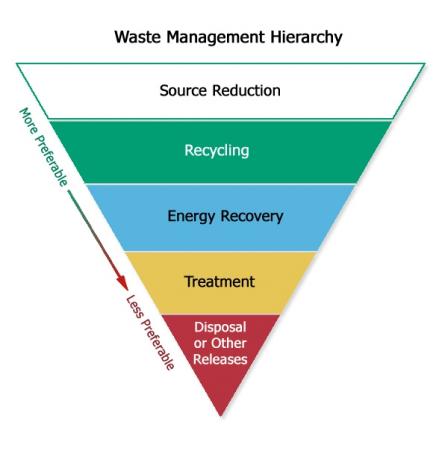Pollution Prevention and Waste Management
Each year, the Toxics Release Inventory (TRI) collects information from more than 21,000 facilities on the quantities of TRI-listed chemicals they recycle, combust for energy recovery, treat for destruction, and dispose of or otherwise release both on and off site as part of their normal operations. These quantities are collectively referred to as the quantity of production-related waste managed![]() production-related wasteThe sum of all non-accidental chemical waste generated at a facility. It is the sum of on-site environmental releases (minus quantities from non-routine, one-time events), on-site waste management (recycling, treatment, and combustion for energy recovery), and off-site transfers for disposal, treatment, recycling or energy recovery..
production-related wasteThe sum of all non-accidental chemical waste generated at a facility. It is the sum of on-site environmental releases (minus quantities from non-routine, one-time events), on-site waste management (recycling, treatment, and combustion for energy recovery), and off-site transfers for disposal, treatment, recycling or energy recovery..
 Looking at production-related waste managed over time helps track facilities’ progress in reducing the amount of chemical waste generated and in adopting waste management practices that are preferable to disposing of or otherwise releasing waste into the environment.
Looking at production-related waste managed over time helps track facilities’ progress in reducing the amount of chemical waste generated and in adopting waste management practices that are preferable to disposing of or otherwise releasing waste into the environment.
Pollution prevention is an essential component of sustainable manufacturing practices. EPA encourages facilities to first to reduce or eliminate the use of TRI-listed chemicals and the creation of chemical waste through source reduction activities such as material substitutions and process modifications. For waste that is generated, the preferred management method is recycling, followed by combusting for energy recovery, treatment, and, as a last resort, disposing of or otherwise releasing the chemical waste into the environment in a safe manner. This order of preference is consistent with the national policy established by the Pollution Prevention Act (PPA) of 1990. This waste management hierarchy is illustrated in the graphic above. While not specifically mentioned in the PPA of 1990, energy recovery is a preferred practice over treatment and disposal and is included in the hierarchy.
TRI Data Considerations
As with any dataset, there are several factors to consider when using the TRI data. Key factors associated with data used in the National Analysis are summarized in the Introduction. For more information see Factors to Consider When Using Toxics Release Inventory Data.
This page was published in January 2021 and uses the 2019 TRI National Analysis dataset made public in TRI Explorer in October 2020.
